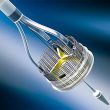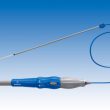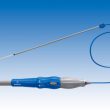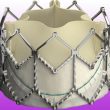Courtesy of Dr. Agustín Vecchia. Paravalvular leak was once considered the greatest disadvantage of TAVR when compared to conventional surgery. Nowadays, new devices and more-experienced operators have managed to “control” this phenomenon, keeping related statistics within acceptable ranges. Repositionable-valve Lotus may probably offer the most effective solution for this event; however, it is associated with high rates of<a href="https://solaci.org/en/2017/07/19/lotus-valve-performance-related-to-pacemaker-implantation-in-patients-after-tavr/" title="Read more" >...</a>
Transcatheter valve replacement in the bicuspid valve is increasingly performed, but challenges remain
As experience increases, transcatheter aortic valve replacement (TAVR) has expanded to different populations and anatomies. This study sought to compare technical and clinical outcomes in patients with bicuspid versus tricuspid aortic stenosis from the Bicuspid AS TAVR Multicenter Registry. Outcomes of 561 patients with bicuspid valves and 4546 patients with tricuspid valves were compared. Propensity score matching was used<a href="https://solaci.org/en/2017/07/05/transcatheter-valve-replacement-in-the-bicuspid-valve-is-increasingly-performed-but-challenges-remain/" title="Read more" >...</a>
Incidence, characteristics, and treatment of valve thrombosis after TAVR
Certain studies have carried out a tomographic follow-up of patients who underwent transcatheter aortic valve replacement (TAVR) and described the frequency of leaflet thrombosis; however, in most cases, it is unclear whether this finding requires some sort of intervention. The difference between this work and those previously published is that this study is not focused on imaging, it<a href="https://solaci.org/en/2017/06/28/incidence-characteristics-and-treatment-of-valve-thrombosis-after-tavr/" title="Read more" >...</a>
REPRISE III: Lotus and CoreValve Compared in High-Risk or Inoperable Patients
The efficacy of transcatheter aortic valve replacement (TAVR) has been well-established. However, its limitations include suboptimal deployment and paravalvular leak. The Lotus system is a fully repositionable and retrievable device with controlled mechanical expansion. It features an adaptive seal to minimize paravalvular leak, it does not require early pacing during deployment, and, given its early<a href="https://solaci.org/en/2017/05/23/reprise-iii-lotus-and-corevalve-compared-in-high-risk-or-inoperable-patients/" title="Read more" >...</a>
Bicuspid Aortic Valve Stenosis Still Challenging for TAVR
Courtesy of Dr. Carlos Fava One of the present challenges of TAVR is bicuspid aortic valve stenosis (AS), since it presents a different distribution and structure, associated to greater and more irregular calcification. There are only small series of devices and their use is still controversial. The study analyzed 561 patients with severe bicuspid<a href="https://solaci.org/en/2017/04/27/bicuspid-aortic-valve-stenosis-still-challenging-for-tavr/" title="Read more" >...</a>
Evolut R: Clinical Results Might Be Better than Those for First-Generation CoreValve
Two recent articles featured in JACC Cardiovascular Interventions showed that short term (at 30 days) outcomes of patients treated with the next-generation self-expanding Medtronic Evolut R valves could present several advantages compared to the original CoreValve, including recapturability. Both analyses reported similar rates of all-cause mortality and stroke. The study carried out by Dr. Jeffrey Popma as<a href="https://solaci.org/en/2017/02/23/evolut-r-clinical-results-might-be-better-than-those-for-first-generation-corevalve/" title="Read more" >...</a>
Asymptomatic Severe Aortic Stenosis in the Elderly: When to Intervene
This work studies the natural history of aortic stenosis and the optimal timing to intervene elderly patients with asymptomatic severe aortic stenosis. This disease is increasingly misdiagnosed in the elderly population, and this goes hand in hand with enhanced therapeutic options. Prior studies on the natural history of this disease were made on<a href="https://solaci.org/en/2017/02/14/asymptomatic-severe-aortic-stenosis-in-the-elderly-when-to-intervene/" title="Read more" >...</a>
Transcatheter Valve Thrombosis: Predictors, Incidence, and Events
This study sought to clarify the incidence and predictors of hypoattenuated leaflet thickening (assumed as leaflet thrombosis) imaging in transcatheter bioprosthesis. This study involved 70 consecutive patients who underwent transcatheter aortic valve replacement with the Edwards SAPIEN-XT device and were subjected to follow-up at 6 months and 1 year through multislice computed tomography (CT), echocardiographic data, and<a href="https://solaci.org/en/2017/01/21/transcatheter-valve-thrombosis-predictors-incidence-and-events/" title="Read more" >...</a>
TAVR vs. Surgery: Valve Performance at Five Years (PARTNER I)
The aim of this study was to evaluate the long-term performance of transcatheter aortic valve replacement (TAVR) and surgically-implanted valves through longitudinal echocardiographic follow-up of the PARTNER I trial patients. The study included all patients receiving TAVR or undergoing surgery who had a post-implant echocardiogram at five years analyzed for peak systolic velocity, mean gradient,<a href="https://solaci.org/en/2017/01/13/tavr-vs-surgery-valve-performance-at-five-years-partner-i/" title="Read more" >...</a>
TAVR in Low-Flow Low-Gradient Aortic Stenosis and Severe Impairment of Systolic Function
Patients with low-flow, low-gradient severe symptomatic aortic stenosis associated with severe impairment of the left ventricular systolic function have shown acceptable outcomes after transcatheter aortic valve replacement (TAVR), according to the multicenter TOPAS-TAVI registry, which demonstrated a relatively low 30-day mortality rate. Considering the very high risk presented by this population involved, a 30-day<a href="https://solaci.org/en/2017/01/06/tavr-in-low-flow-low-gradient-aortic-stenosis-and-severe-impairment-of-systolic-function/" title="Read more" >...</a>









